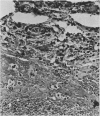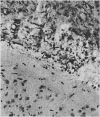Abstract
Pathologic examination in a case of fatal intracerebral hemorrhage from a berry aneurysm showed that the "sentinel" or warning headache in this patient was due to the leakage of blood into the subarachnoid space through a previous small tear in the wall of her saccular aneurysm. Oribital pain, transient, dysphasia, dizziness and, later, meningismus might have prompted the performing of a lumbar puncture to determine the presence of blood in the cerebrospinal fluid. This type of event is the likely pathogenetic mechanism for the premonitory headache that may precede a lethal rupture of a saccular aneurysm.
Full text
PDF

Images in this article
Selected References
These references are in PubMed. This may not be the complete list of references from this article.
- GILLINGHAM F. J. The management of ruptured intracranial aneurysm. Ann R Coll Surg Engl. 1958 Aug;23(2):89–117. [PMC free article] [PubMed] [Google Scholar]
- HYLAND H. H. Prognosis in spontaneous subarachnoid. Arch Neurol Psychiatry. 1950 Jan;63(1):61-78, illust. doi: 10.1001/archneurpsyc.1950.02310190067005. [DOI] [PubMed] [Google Scholar]
- Locksley H. B. Natural history of subarachnoid hemorrhage, intracranial aneurysms and arteriovenous malformations. J Neurosurg. 1966 Sep;25(3):321–368. doi: 10.3171/jns.1966.25.3.0321. [DOI] [PubMed] [Google Scholar]






